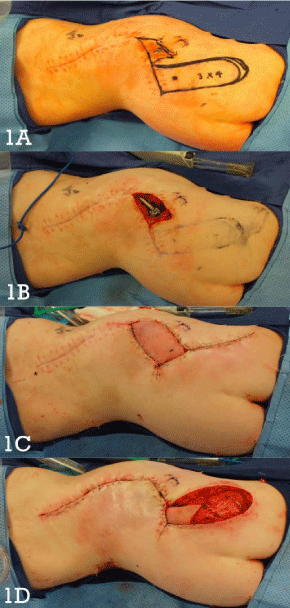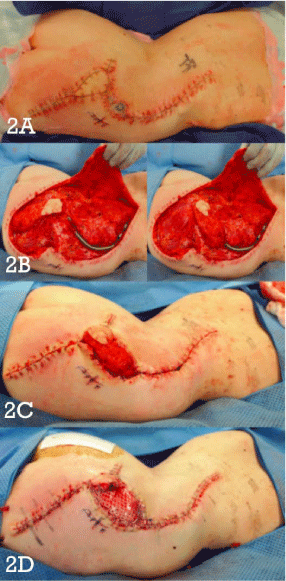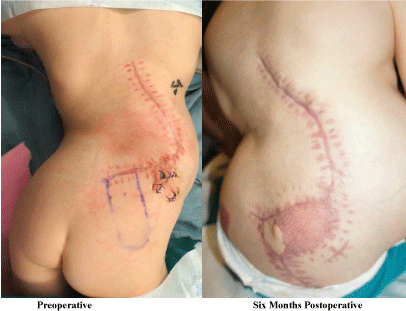Research Article
A Modified Vascular Delay Technique to Keep a Congested Perforator-Based Propeller Flap Afloat
Chen W* and Heineman J
Department of Surgery, University of Iowa Hospitals and Clinics, USA
*Corresponding author: Wei F. Chen, Department of Surgery, Division of Plastic & Reconstructive Surgery, University of Iowa Hospitals & Clinics, Iowa, 200 Hawkins Drive, 1537, JCP, Iowa City, Iowa 52242-1086, USA
Published: 16 Jun 2016
Cite this article as : Chen W, Heineman J. A Modified
Vascular Delay Technique to Keep a
Congested Perforator-Based Propeller
Flap Afloat. Clin Surg. 2016; 1: 1037.
Abstract
Background:The perforator-based propeller flap is a versatile technique that has proven utility in complex lower extremity and lumbar reconstructions. Yet, this flap is prone to venous congestion due to its single-perforator design. In the setting of a congested propeller flap, it is often abandoned and a secondary flap option is utilized. The vascular delay technique has been successfully used to augment perfusion in other types of flaps; however, it has not been described for the propeller flap. We present our experience of salvaging a congested lumbar artery-based propeller flap using a modified technique.
Method: A seven year old female with scoliosis, who previously underwent lumbar spine fusion,developed a non-healing lumbar wound with hardware exposure (Figure 1A). The wound was debrided (Figure 1B). We then located a lumbar artery perforator by Doppler ultrasound and raised a propeller flap. However, the flap became congested immediately upon transposition (Figure 1C). After ruling out mechanical obstruction, observing patiently, treating vasospasm with papaverine, and returning the flap to its anatomic position - the congestion persisted. The flap was de-epithelialized, to treat congestion and decrease metabolic demand, and the congestion promptly resolved (Figure 1D). After a two week delay (Figure 2A), successful definitive flap transposition was performed (Figure 2B). No congestion was observed (Figure 2C). A split thickness skin graft was placed to cover the de-epithelized flap (Figure 2D). The patient had an uneventful hospital and recovery course.
Results: At six months postoperatively, the patient demonstrated healthy and durable coverage of the spinal hardware (Figure 3).
Discussion: To our knowledge, this is the first described use of vascular delay to salvage a congested propeller flap. We propose a flowchart (Figure 4) to assist with intraoperative decision making after observing flap congestion upon initial transposition. If necessary, vascular delay may be applied to
prevent abandonment of an otherwise viable flap.
Keywords: Propeller flap, Vascular delay
Background
The perforator-based propeller flap is a versatile technique that has proven utility in complex lower extremity and lumbar reconstructions. A propeller flap is defined as an island flap that reaches its recipient site through axial rotation [1]. These flaps do not sacrifice source arteries and preserve the vascularity of local muscle, fascia, bone, fat, and other anatomical structures [2]. Koshima and Soeda [3] first reported the reliability of a skin flap vascularized by a perforator artery in a deep inferior epigastric perforator flap. The term “propeller flap” was first described by Hyakusoku et al. [4].
Yet, the perforator-based propeller flap is particularly prone to venous congestion due to its single-perforator design. In the setting of a congested propeller flap, it is often abandoned and a secondary option is utilized. The vascular delay technique has been successfully used as an alternative option to augment perfusion in other types of flaps; however, it has not been described for the propeller flap. We present our experience of salvaging a congested perforator-based propeller flap using a modified technique.
Methods
A seven-year-old female with scoliosis, who previously underwent hemivertebrae resection
and posterior lumbar spinal fusion, presented with a chronic non-healing wound and hardware
exposure (Figure 1A). An 8 x 4 cm lumbar artery perforator-based
propeller flap was designed with Doppler ultrasound (Figure 1B).
The wound was debrided and the flap was raised. Immediately after
rotation 100 degrees, the flap became congested and persisted after
observation and papaverine administration (Figure 1C). Returning
the flap back to its anatomic position significantly resolved the
congestion but an unacceptable level persisted. To decrease metabolic
demand, the fat deep to the superficial layer was debulked and the
skin was de-epithelialized. The flap was then placed back in-situ for
delay (Figure 1D).
Figure 1
Two weeks after the surgery, the patient returned to the operating room (Figure 2A). The propeller flap was again transposed to cover the exposed hardware (Figure 2B). This time the flap had no signs of congestion (Figure 2C). The de-epithelialized portion of the propeller flap was covered with a split thickness skin graft (Figure 2D).
The patient had no postoperative complications. She was discharged to an intermediate facility on postoperative day six in satisfactory condition. The patient was instructed to use a specialty bed for pressure offloading for six weeks postoperatively.
Results
At two weeks postoperatively, the patient’s propeller flap
appeared well perfused and the skin graft had 100% uptake. At six
months, her flaps remained well healed and with complete spinal
hardware coverage (Figure 3).
Figure 2
Figure 3
Discussion
The perforator-based propeller flap has been shown to be a
useful and effective reconstruction option with the potential to cover
large defects with skin paddles that may be rotated from significant
distances, thus preserving local anatomic structures and reducing
donor site morbidity. Compared to the free flap, the propeller flap
technique allows shorter operating times and does not require
microsurgical anastomosis [5].
Figure 4
However, venous congestion - with the threat of partial or complete flap loss - remains a serious potential complication, especially in the setting of underlying hardware. In a systematic review of 15 caseseries with 186 reports of lower extremity perforator-based propeller flaps, Gir et al. [6] noted an overall complication rate of 25.8% with a failure rate of 1.1%, with the most common complications being partial flap loss (11.3%) and venous congestion (8.1%). Innocenti et al [7]. further reported a case-series of 66 lower extremity perforatorbased propeller flaps with an overall complication rate of 42% and failure rate of 2%, with the most common complications being venous congestion (17%), superficial necrosis (11%), and partial flap loss (2%).
In the setting of a congested propeller flap, it is often abandoned
and a secondary option is utilized. We present a flowchart (Figure 4)
that may be used in the setting of flap congestion after transposition.
If there is mechanical obstruction - such as pedicle kinking - relieve
it, observe, and treat vasospasm with papaverine if necessary. If
congestion remains, return flap to anatomic site. Debulk the flap if
congestion persists to decrease its metabolic demand. If still congested,
a free flap option may be utilized to prevent flap abandonment [8]. If
congestion is relieved, consider the vascular delay technique.
Karacalar et al [9]. first confirmed a benefit of vascular delay in rats and then in nine successful human inferior epigastric neurovenous flaps. Delay has been shown to stimulate reorientation of vessels, improve blood flow, and increase tissue resistance to hypoxia [10]. Delay has been successfully used as an alternative option to augment perfusion in other types of flaps; however, it has not been described for the propeller flap. To our knowledge, this is the first described use of delay for this specific type of tissue transfer.
References
- Pignatti M, Ogawa R, Hallock G, Mateev M, Georgescu AV, Balakrishnan G, et al. The “Tokyo” Consensus on Propeller Flaps. Plast Reconstr Surg. 2011; 127: 716-722.
- Ayestaray B, Ogawa R, Ono S, Hyakusoku H. Propeller flaps: Classification and clinical applications. Ann de Chir Plast Esthet. 2011; 56: 90-98.
- Koshima I, Soeda S. Inferior epigastric artery skin flap without rectus abdominis muscle. Br J Plast Surg. 1989; 42: 645-648.
- Hyakusoku H, Yamamoto T, Fumiiri M. The propeller flap method. Br J Plast Surg. 1991; 44: 53-54.
- Hyakusoku H, Ogawa R, Oki K, Ishii N. The perforator pedicled propeller (PPP) flap method: report of two cases. J Nippon Med Sch. 2007; 74: 367- 371.
- Gir P, Cheng A, Oni G, Mojallal A, Siant-Cyr M. Pedicled-perforator (propeller) flaps in lower extremity defects: a systematic review. J Reconstr Microsurg. 2012; 28: 595-601.
- Innocenti M, Mechichini G, Baldrighi C, Delcroix L, Vignini L, Tos P. Are there risk factors for complications of perforator-based propeller flaps for lower-extremity reconstruction? Clin Orthop Relat Res. 2014; 272: 2276- 2286.
- Chen WF, Tsao CK, Cheng MH. A novel salvage approach for pedicle axial flap – free-ization of pedicle internal mammary artery perforator flap. Microsurgery. 2012; 32: 314-317.
- Karacalar A, Idil O, Demir A, Guneren E, Simsek T, Ozcan M. Delay in neurovenous flaps: experimental and clinical experience. Ann Plast Surg. 2004; 53: 481-487.
- Fisher J, Gingrass MK. Basic principles of skin flaps. In: Georgiade GS, Riefkohl R, Levin LS. Plastic, Maxillofacial and Reconstructive Surgery. Baltimore: Williams and Wilkins. 1997; 22-24.



